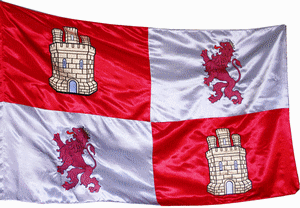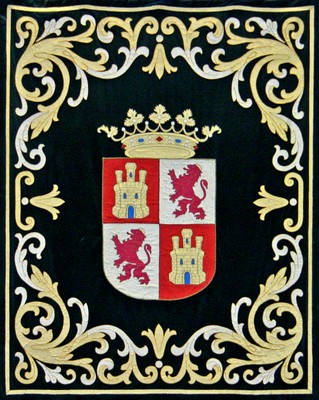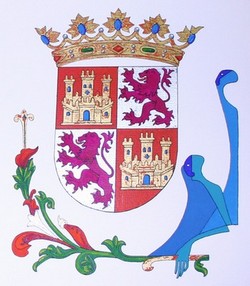Menú principal
- About Castilla y León
-
Geography and Population

-
Historical and cultural community

-
Autonomic institutions

-
Castilla y León awards

About Castilla y León

About Castilla y León

The historic origin of the flags is related to the distinctive signs with military purposes. Cloths when kings and noblemen who went to the war, used to draw the figures of their coat of arms to identify their armies. They decorated them with their colours, so that the fighters could see them during the confusing course of the battle.
The flag, raised in the military camps, was also a sign that helped the forces distribution, and the flag hoist in castles and ships, meant that the master was in that place. However, the most important thing was not the flag but the coat of arms that could be seen in the elevated cloth. In Spain, and contrary to what had been the German peoples -the Visigoths-, introduced the roman's custom: the tradition to decorate the shields with colours or symbolic figures. This high medieval tradition, with the passing of the time, gave way to the appearance of coats of arms during the XI and XII century.
According to the legend, the king Pelayo ordered to draw a lion in his shield as an acknowledgement for killing one, when he was prisoner in Cordoba, after the Guadalete battle. The lion's heraldry figure passed to his descendants that were the Kings of Oviedo, and it passed then, to the Kings of León. A little bit less romantic are other historic explanations that attribute the lion's origin to the own's León kingdom, whose name developed from the latin word "Legio" (due to the Legio VII Gemina that had there the camp) to the word "Leo".
Also the castle has its own chronicle: the count Fernán González was the one who ordered to draw a castle in his shield, as a way to expressing that he had conquered Castilla when the king of León made his count title hereditary.

None of those elements were present in the official ensigns since the first moment. During the reconquest process against the Muslims, and until the end of the XI century, the Christian kings of the Iberian Peninsula used in their coat of arms and ensigns the cross sign. Even that this was not always the same- different shapes and colours- there was a predilection for the Latin or Greek cross, and the red, white and yellow colours.
Since the XII century, the monarchs started to change the traditional cross for a lion (Alfonso VII) or a castle with three towers (used by Alfonso VIII in his stamps and coins). The definitive flag was designed once the two kingdoms are together (year 1230) under Fernando III called El Santo (the Saint). It will be a symbol of the union of both kingdoms.
When due to territory legacies and marriages between noble people, two kingdoms had the same monarch- even they had independent institutions, law, language, and customs-, the heraldic law established that the flag or coat of arms had to be divided in two. In each part had to be the colours or figures of the kingdoms. If the union between two kingdoms was considered as definitive, like the case of Castilla y León, then the flag or coat of arms had to be divided in four equal parts and the figures and colours of both kingdoms had to be alternated. That aimed at symbolising the union, and that if they used to be two kingdoms, they were now just one.

But one thing is the alternation of the symbols and other their meaning. The interpretation of colours and figures of Castilla y León flag is also given by the heraldic science. According to this, the lion is a symbol of watchfulness, authority, domination, monarchy, sovereignty, magnanimity, majesty and bravery. On the other hand, the castle represents the grandeur and elevation, as well as shelter and protection.
For some experts, the coat of arms comes from a Visigothic culture that is still in mind, thanks to a right symbolic summary of all the elements that constituted the origin and driving force of our ancient history. This way, it is perfectly expressed the appropriate union between the astur-leones Visigothic aristocracy, with its political, economical social and religious characteristics, as it was a monarchist, theocratic, military and feudal kingdom, that would be represented by a lion. The castle, symbol of communal power and the defence of the people's freedoms, would be the Visigoth's representation of the working class, with its democratic, secular, agricultural and forestry tendencies.
Regarding the colours, the red symbolises strength, victory, daring, highness and shrewdness. Yellow represents nobility, magnanimity, wealth, power, light, perseverance and wisdom. And finally, white, represents purity, integrity, obedience, firmness, watchfulness, eloquence and victory. Since the XIII century, with the reign of Fernando III The Saint, the colours traditionally used in Castilla y León have been red and white, changing from red to white and from white to red.

The region's heraldic tradition lay the foundations, but the definition of a unique and perfectly shaped "logo" is a little bit more complicated. With the implementation of the autonomic process, it was chosen the institutional emblem for the Autonomous region of Castilla y León. It was not an easy task. It started with a long, delicate and rigorous process of historic research with changes on the different models of Castilla y León coat of arms, due to the appearance of new documents.
The Decree of 1989 from the Regional Ministry of Presidency and Territorial Administration changed the escutcheon, in order to make it more rigorous with the heraldic laws. It introduced a more organised, well-balanced and clear design, while the figures and shape's design was also more eye-catching and appropriate.
The last important change of the Statute of Autonomy of Castilla y León (Organic Law 4/1999, 8th January), includes an express mention to escutcheon.
In the autonomous region of Castilla y León there is a special feature: it has a duality of emblems. Together with the flag, there is also a banner of Castilla y León. That is why the region has double vexiolologic or flag representation. They can both be used, but not simultaneously, as we are before the same symbol. Moreover, the Statute of Autonomy makes a difference between both of them in the above-mentioned article 4.
It says that "the flag of Castilla y León is divided in four and gathers the symbols of Castilla y León (...). The flag shall be fluttering in all the region's official institutions and ceremonies, on the right of the Spanish flag. The banner shall be a escutcheon divided in four on a traditional crimson background. A Regional Government Decree will regulate the use and the design of the shape and size of the region's symbols. Each province and town council will keep the flags and emblems that are traditional for them".
Why two flags? A long and complex historic process caused confusion between two types of purple colour (a strong purple: colour with a hue between that of violet and red; and a light purple: colour with a hue between that of crimson and blue), and that is why it had to be claimed as regional ensign the light purple colour of Castilla banner. The confusion started when the royal army of Charles I defeated the commoners in the Villalar battle in 1521. At that moment the House of Austria arms will replace the old coat of arms and banner of Castilla y León.
With the passing of the time, the Austria's royal escutcheon made disappear the former and started the wrong association between the strong purple and the light purple colour. This will continue after the creation of some military units of "Royal Guards" during the reign of Philip IV, and during the XVIII and XIX centuries, by the Spanish Republicans of the I and II Republic: they also used this light purple colour as a symbol. We now know that historically the right thing to say is that the Castilla banner is crimson, and not purple.
The banner kept at the Colegiata de San Antolín, in Medina del Campo (Valladolid), from the beginning of the XVI century, was the model to create the Castilla y León banner, even they made some changes in the ornaments and figures. That design was carried out before the autonomic process, by the Valladolid Town Hall. Other Corporations followed its model in the next few months, and they accepted the double flag representation in the Committee that was writing the Statute of Autonomy Project. That way it was introduced and approved in the text.